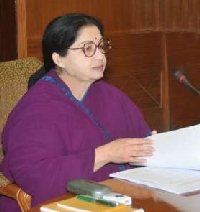India is looking towards the commissioning of two Russian-designed reactors at Kudankulam after the cabinet of Tamil Nadu gave its go-ahead.
 |
| Chief Minister Jayalalithaa chairs cabinet discussions on Kudankulam (Image: Government of Tamil Nadu) |
The two Kudankulam reactors have a long and somewhat chequered history. First mooted as a project in the late 1980s under Indian prime minister Rajiv Ghandi and Russian president Mikhail Gorbachev, work finally began on the two VVER-1000 reactors in 2002. The units are being built by the Nuclear Power Corporation of India Ltd (NPCIL) under the supervision of Russian supplier AtmoStroyExport through a Russian-financed contract. The plants were completed shortly before the Fukushima accident of March 2011, since when the sudden growth of a powerful local protest movement has effectively brought commissioning to a standstill.
The cabinet decision announced by chief minister Selvi J Jayalalithaa in a five-page document was reached after considering the findings of a number of specially appointed panels and committees which had looked into the plant's safety as well as holding meetings with representatives of the protestors. The cabinet had concluded from the reports that the plant was safe, and was not at risk from large-scale earthquakes or tsunamis.
One outcome of the protest movement, spearheaded by S P Udayakumar and his People's Movement Against Nuclear Energy, has been an increase in efforts made by Indian nuclear leaders to engage more actively in public discussion around nuclear energy, with nuclear operators becoming more proactive in supporting their local communities. The Tamil Nadu decision includes recognition of the need to create awareness among the local population and the provision of funding for community welfare projects in villages near the plants.
Indian prime minister Manmohan Singh recently alleged that protests against the nuclear plant had been bankrolled by overseas NGOs.
Researched and written
by World Nuclear News




_23621.jpg)

_63865.jpg)
_18570.jpg)





